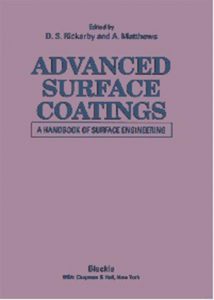Materials Engineering Centre
Harwell Laboratory
and
A. MATTHEWS
Director of the Research Centre in Surface Engineering
Department of Engineering Design and Manufacture
University of Hull
Contents
Introduction
D.S. RICKERBY and A. MATTHEWS
Surface engineering: the key to optimised perfonnance
The main surface engineering technologies
Traditional surface engineering processes
Advanced surface engineering processes
Coating structure and characterisation
Use of plasmas in deposition technologies
Processing plasmas
DC-diode plasmas
RF discharges
Plasmas in the presence of magnetic fields
Applications of magnetic fields to plasmas
Microstructure of sputter deposited films
Conclusions
Ion implantation and ion-assisted coating
Beam-induced processes
Tribological applications
Applications to corrosion resistance
Equipment
The economics of ion beam processing
Conclusions
Evaporation
Practical aspects of evaporation processes
Resistively heated sources
Inductively heated sources
Electron beam evaporation
Arc evaporation
Laser-induced evaporation
Coating thickness distributions and unifonnity
Lateral thickness unifonnity
Front to back thickness unifonnity
Absolute thickness fall-off
Evaporation principles
Evaporation of pure metals
Evaporation of alloys and compounds
Further considerations in electron beam evaporation
Selected applications for evaporative techniques
Large-area sheet coating
Bond coats and thennal barriers
Conclusions
Sputter deposition
Introduction and historical perspective
Basic aspects of sputtering
Interactions on the target surface
Target considerations
Process parameter effects
Sputtering techniques
Reactive vs non-reactive processes
Diode sputtering
RF sputtering
Triode sputtering
Magnetron sputtering
Unbalanced’ magnetron sputtering
Plasma characteristics and ion bombardment
Process control
Applications of sputtered hard coatings
Hard coatings on cutting tools
Sputtered decorative coatings
Engineering components
Industrial coating systems
Future trends
Plasma-assisted physical vapour deposition
The DC-diode argon discharge
The negative glow
The sheath regions
The basic mechanisms
Bombardment of the cathode in argon discharges
Ion and neutral energy distributions
Further ionisation considerations
Practical ion-plating discharges
Metal species
Reactive gas
Impurities
Practical considerations and system details
Commercial PAPYD systems
Coating variability
Process control
Adhesion
Other process factors
Applications and case studies
Industrial applications of PAPYD coatings
PAPYD vs CYD coatings in metal-cutting applications
Other applications
Conclusions
Thermally activated chemical vapour deposition
Principles of CYD
The CYD system
Gas-dispensing system
CYD reactors
Exhaust system
Design of a CYD process
Thermodynamics
Selection of precursors
Adhesion
Substrate
Gas flow dynamics
Rate-limiting steps
Nucleation
Deposition mechanisms
Morphology and microstructure
Applications of the CYD technique
Summary and concluding remarks
Plasma-assisted chemical vapour deposition
Discharge chemistry and physics
Basic processes occurring in a glow discharge plasma
Kinetic and thermodynamic factors
Plasma-surface interactions
PACYD equipment requirements
Applications of PACYD
Wear-resistance coatings
Thermochemical processing
Deposition of mixtures and multilayer structures
Summary
Thermal spraying
Thermal spraying
Wire spraying
Electric arc spraying
Powder flame spraying
High-velocity combustion processes
Arc plasma processes
Other techniques
Substrates and surface preparation
Coating properties
Applications
Summary
Laser surface treatment
Practical aspects of laser processing
Types of laser and their operation
Surface condition
One-dimensional thermal heating and cooling
Laser techniques
Laser surface melting
Laser surface alloying
Laser cladding
Laser chemical vapour and physical vapour deposition
Current and future applications of laser processing
Surface texturing
Enhanced electroplating
Non-contact bending
Thermal deformation
Magnetic domain control
Particle injection
Stereolithography
Conclusions
Characterisation of coatings and interfaces
Electron spectroscopies
Photoelectron spectroscopy
Auger electron spectroscopy
Electron microscopies
Ion spectrometry and microscopy
Secondary ion mass spectrometry
Rutherford backscattering
Photospectroscopies and microscopies
Infrared spectroscopy
Raman spectroscopy
X-ray diffraction analysis
Conclusions
Bibliography
Evaluation of coatings
Mechanical property assessment
Assessment of coating hardness
Measurement of coating adhesion
Tribological assessment of coatings
Summary and future developments
Market perspective and future trends
Future directions in surface engineering
Future developments in process technology
Developments in process understanding
Design-related factors
New materials and future markets for surface engineering
Composite materials
High-temperature superconducting ceramics
Diamond and DLC films
Business opportunities
References
Index


